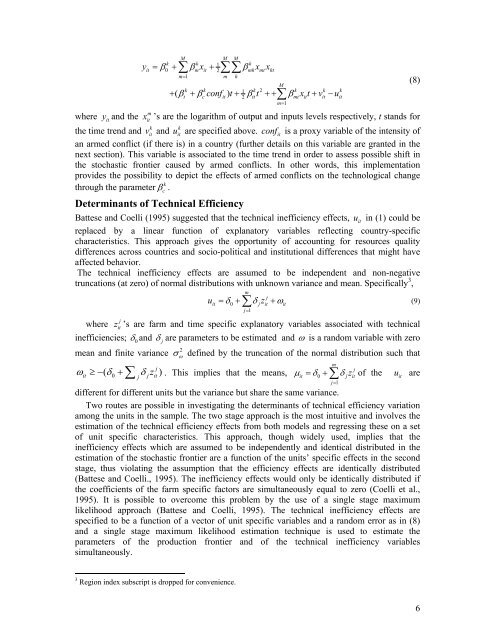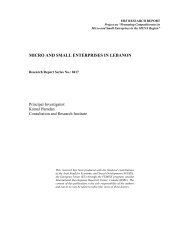Agricultural Productivity and technological gap between MENA ...
Agricultural Productivity and technological gap between MENA ...
Agricultural Productivity and technological gap between MENA ...
You also want an ePaper? Increase the reach of your titles
YUMPU automatically turns print PDFs into web optimized ePapers that Google loves.
where yit<strong>and</strong> thethe time trend <strong>and</strong>M M Mk k 1kit= β0 + ∑βm it+2∑∑βmh mt htm=1m hMk k 1 k 2k k k+ ( βt + βc confit ) t +2βtt t ++ ∑ βmt xitt + vit −uitm=1y x x xmxit’s are the logarithm of output <strong>and</strong> inputs levels respectively, t st<strong>and</strong>s forkvit<strong>and</strong>kuitare specified above.(8)confitis a proxy variable of the intensity ofan armed conflict (if there is) in a country (further details on this variable are granted in thenext section). This variable is associated to the time trend in order to assess possible shift inthe stochastic frontier caused by armed conflicts. In other words, this implementationprovides the possibility to depict the effects of armed conflicts on the <strong>technological</strong> changekthrough the parameter βc.Determinants of Technical EfficiencyBattese <strong>and</strong> Coelli (1995) suggested that the technical inefficiency effects, uitin (1) could bereplaced by a linear function of explanatory variables reflecting country-specificcharacteristics. This approach gives the opportunity of accounting for resources qualitydifferences across countries <strong>and</strong> socio-political <strong>and</strong> institutional differences that might haveaffected behavior.The technical inefficiency effects are assumed to be independent <strong>and</strong> non-negativetruncations (at zero) of normal distributions with unknown variance <strong>and</strong> mean. Specifically 3 ,mjuit = δ0+ ∑ δjzit + ωit(9)whereinefficiencies; δ0<strong>and</strong>mean <strong>and</strong> finite variancej=1jzit’s are farm <strong>and</strong> time specific explanatory variables associated with technicaljit 0 j j itδjare parameters to be estimated <strong>and</strong> ω is a r<strong>and</strong>om variable with zero2σωdefined by the truncation of the normal distribution such thatjω ≥− ( δ +∑ δ z ). This implies that the means, µit= δ0+∑δjzitof the uitaredifferent for different units but the variance but share the same variance.Two routes are possible in investigating the determinants of technical efficiency variationamong the units in the sample. The two stage approach is the most intuitive <strong>and</strong> involves theestimation of the technical efficiency effects from both models <strong>and</strong> regressing these on a setof unit specific characteristics. This approach, though widely used, implies that theinefficiency effects which are assumed to be independently <strong>and</strong> identical distributed in theestimation of the stochastic frontier are a function of the units’ specific effects in the secondstage, thus violating the assumption that the efficiency effects are identically distributed(Battese <strong>and</strong> Coelli., 1995). The inefficiency effects would only be identically distributed ifthe coefficients of the farm specific factors are simultaneously equal to zero (Coelli et al.,1995). It is possible to overcome this problem by the use of a single stage maximumlikelihood approach (Battese <strong>and</strong> Coelli, 1995). The technical inefficiency effects arespecified to be a function of a vector of unit specific variables <strong>and</strong> a r<strong>and</strong>om error as in (8)<strong>and</strong> a single stage maximum likelihood estimation technique is used to estimate theparameters of the production frontier <strong>and</strong> of the technical inefficiency variablessimultaneously.mj=13 Region index subscript is dropped for convenience.6
















